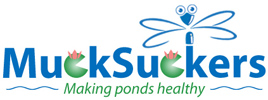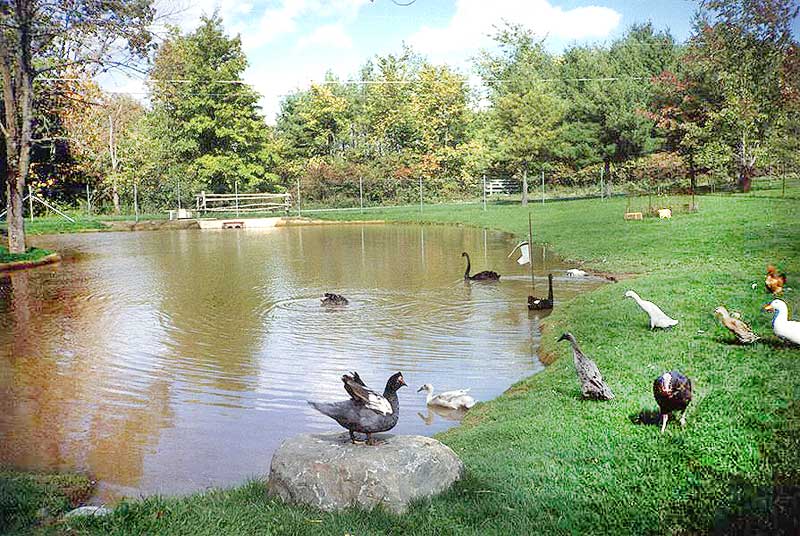
by John Monahan | May 18, 2015 | Dredging, Pond Maintenance
The conventional way of dredging a pond is a very messy task. This usually involves first draining the pond, then allowing time for the sediment to dry. All wildlife is either killed off or relocated during this aspect of the operation.
Heavy equipment is then used to scrape the bottom of the pond. Dump trucks then haul away the sloppy sludge material. This process not only destroys the pond’s wildlife but also the entire landscape around the pond.
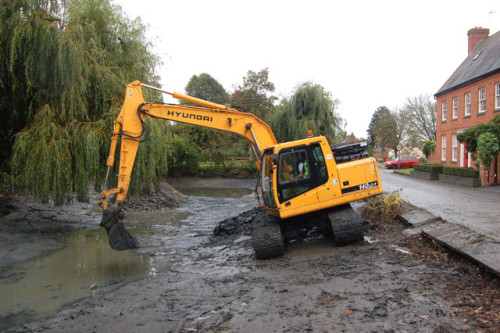
Conventional dredging where a pond is mostly dried out first. As you can see, the heavy equipment can easily damage the surrounding area.
After the conventional dredging is done, all banks will then need to be restored, trees and grass or other landscaping and will need to be replaced or reseeded. In many cases conventional dredging will not work. Sometimes ponds are “spring fed” and never dry out completely. Other ponds are completely surrounded by houses, trees, power lines, etc, leaving pond owners no option to use heavy equipment.

Another method of dredging involving heavy equipment on a barge. It’s better than the first method but can still damage the environment and pond liners. Plus it’s time consuming, awkward and costly.
Another option to pond dredging is the Sediment Removal Solutions of Ohio approach.
SRS uses scuba divers and high-volume suction pumps to suction the sediment out without the harmful repercussions of conventional dredging. The sediment is simply pumped to another location, either allowed to be absorbed into the surrounding landscape or contained within a geotextile container. This container passively filters out the water allowing the sediment to completely dry. This material can be hauled away usually at a fraction of the cost of hauling wet material.
The SRS of Ohio approach to restoring ponds is environmentally friendly, far less invasive, and leaves little to no ecological footprint behind unlike commercial dredging. It’s a great alternative to traditional dredging techniques.
Contact us today with any pond dredging related questions you have!
Call us (1-877-772-MUCK) or email us!
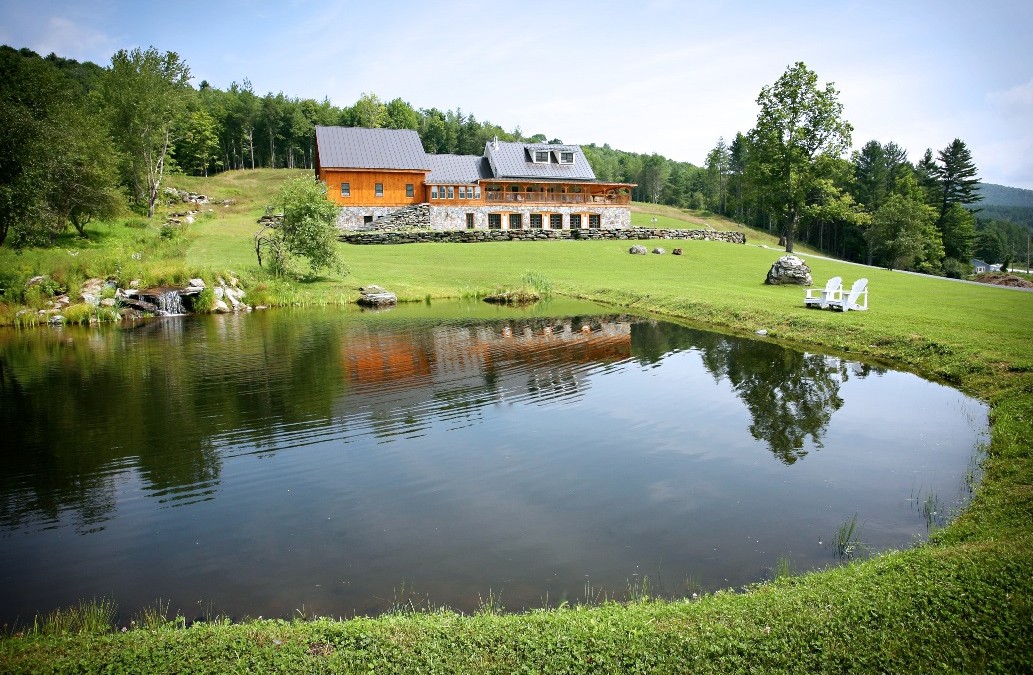
by John Monahan | May 6, 2015 | Dredging, Pond Maintenance
Dredging a pond is a damaging process. All water and all wildlife must be removed before the heavy equipment is brought in – and heavy equipment means felled trees and tattered shorelines.
Essentially, dredging is like saying goodbye to (or at best relocating) your wildlife, and then rebuilding the landscape after all the trucks have left the site. Surely, it’s a last-gasp choice to clean or save a pond. Surely, there’s a better way.
There is.
Sediment Removal Solutions of Ohio (SRS) employs scuba divers to avoid the wear and tear of conventional dredging. The divers use high volume suction pumps to remove the sediment from the bottom of the pond. The sediment is sent to another location, where it can be contained in a geotextile container, or simply absorbed into the land. (A geotextile container will allow the water to slowly drain away, so that the remaining sediment can be hauled away as a much lighter, and much more inexpensive load.)
With this system, no wildlife needs to be relocated. It leaves the surrounding environment virtually unscathed. The results are fantastic, too: with proper upkeep, a cleaning of this sort should last from 15-20 years.

The grounds surrounding a pond are often pristine, and difficult to bring back if damaged. (Photo courtesy of sedimentremovalsolutions.com)
Here are some added benefits, from the main SRS website:
- The restoration of the natural bottom without disturbing existing aquatic life in your pond.
- Cleaner water and a healthier ecosystem without damage to the existing landscape.
- A dramatic reduction of weed and algae problems.
- An expanded living space for your fish at a cost up to 75% less than dredging.
- A reduction in toxic gases and nutrients.
The cost of this service is dependant on the size of the pond and the amount of sediment. SRS utilizes daily rates, and these can be obtained through request. Meanwhile, the cost of dredging can mean so much more. Again, from the main SRS website:
“The average cost (for mechanical excavation) is around $75,000 per acre. To dragline wet, remember the sediment is in a soft liquid state. When the bucket hits the sediment, the sediment explodes in the water, saturating the entire water column, (like a spoon stirring chocolate in milk.) Yes, you will have a deeper pond, because they can remove the hard clays and soils at the bottom when they dig. But when they are finished and the pond settles, you are right back where you started.”
When it comes time to dredge, it’s good to know that there are options out there. SRS affords its customers a less damaging and more environmentally sound alternative to old fashioned dredging.
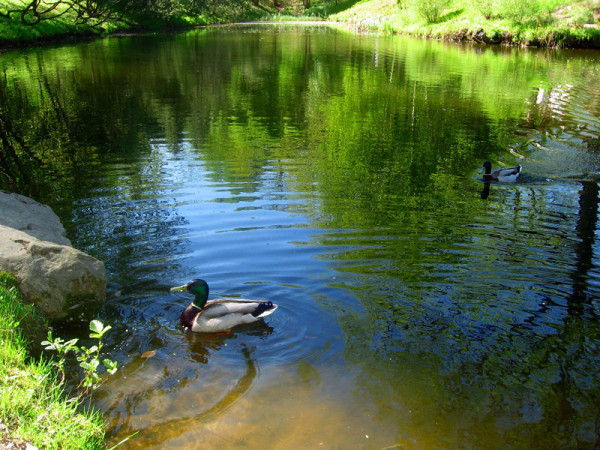
by John Monahan | Apr 14, 2015 | Aeration, Pond Maintenance
Without proper aeration, pond water can become stratified, creating a “sick”, unhealthy pond.
Think of a pond in layers. Warm water is less dense, therefore it will sit on top of colder, denser, deeper water. This stratification of water into layers is more common and pronounced in the summer when surface temperatures are greater.
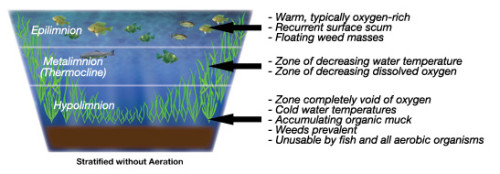
An unhealthy pond with layers, or stratification. Without aeration, static temperature zones are created.
The warm, top layer is called the epilimnion.
Then there’s the middle layer called the metalimnion. This is also referred to as a “thermocline“. The thermocline is the transition layer between the warmer surface layer and the colder deep water layer.
The cold, bottom layer is the hypolimnion.
As summer wears on, oxygen in the lower hypolimnion layer is depleted by organisms there. As oxygen is depleted, fish and other aerobic organisms move to the other layers, go dormant or die off.
Introducing aeration to a pond changes everything. A bottom aeration system creates a vertical current. Bottom aeration uses the rising force of millions of small bubbles to turn the pond water over. This allows all levels of the pond to carry dissolved oxygen.
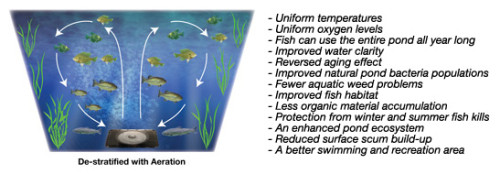
The water on the bottom level moves up throughout the pond. This eliminates the thermal stratification or separation of water layers. Oxygen levels increase throughout the pond which expands the living space and promotes the natural breakdown of organic material at the bottom of the pond.
We can consult with you on proper aeration and other solutions for your pond. Contact us today with any questions you have!
Call us (1-877-772-MUCK) or email us!
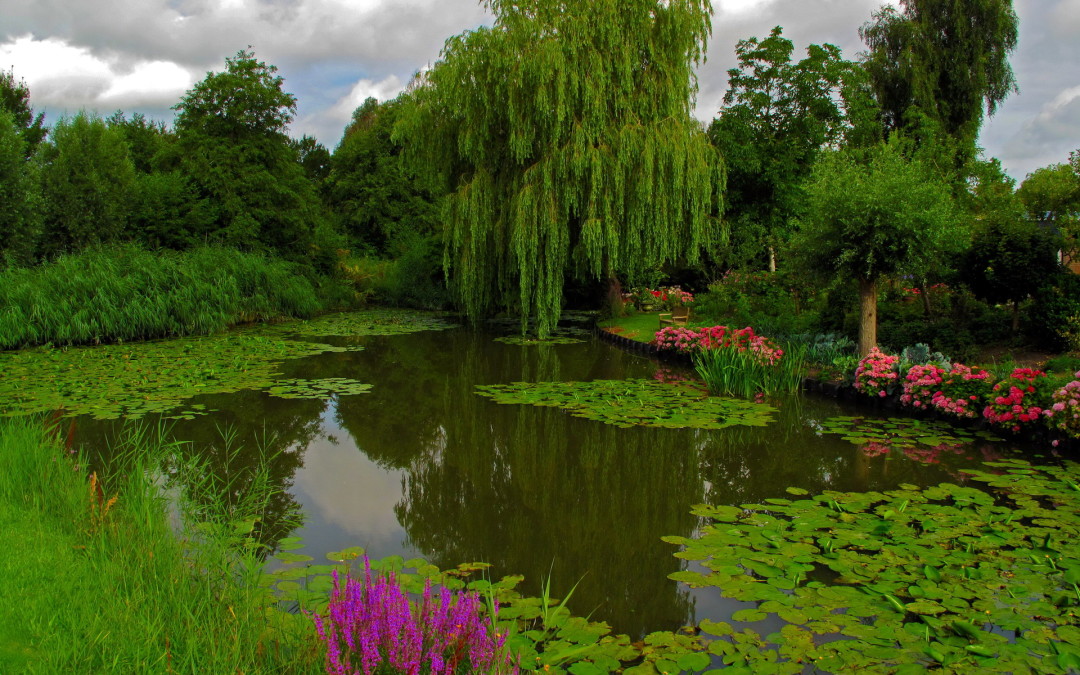
by John Monahan | Apr 13, 2015 | Environmental, Pond Maintenance
There’s a lot that goes into cleaning a pond. Traditionally, and still today, most companies use dredging to clean ponds.
Dredging is the act of removing sediment and muck (decaying leaves, algae and biomass) from the bottom of a body of water. The muck is harmful because it releases toxins and an overdose of nutrients, which in turn grows more algae and kills aquatic life.
Our method, on the other hand, doesn’t rely on excavation of your pond. Instead our highly skilled divers go down into your pond and vacuum out the sediment. It is a less expensive method, less invasive and also restores a healthy balance to the pond.
The traditional method of pond cleaning, mechanical dredging, is very harmful to the ecosystem of a pond. In dry dredging, the pond must be drained completely before being excavated, which usually means killing off the aquatic life.
In wet dredging, sediment and muck is dispersed throughout the water and releases buried toxins, which ends up killing the aquatic life as well. On top of that, the waste must be trucked away, causing damage to the surrounding area and letting muddy water drain out along the way. Additionally, getting the heavy equipment where it needs to be can be tricky, costly and can damage the environment.

Our sediment removal system is much more efficient and environmentally friendly. We use suction pumps to vacuum up sediment and muck from the bottom of the pond, without disturbing the aquatic life. This way, your pond is cleaned of toxins and excessive algae growth and will have a restored, healthy ecosystem.
As a bonus, expensive hauling costs can be reduced. Rather than trucking away wet and heavy sediment, we pump it into geotextile silt containers. There the water can runoff and leave the sediment to dry. This rich soil can be used as landscaping material or simply graded out and reseeded with grass.
The nutrient rich sediment at the bottom of your pond does have a purpose. While it can be harmful in the pond, after being vacuumed out, this sediment can be mixed with compost to create enriched soil.
In order for sediment and muck to be useable it must be laid out to remove excess water. The sediment will often be suctioned into a dewatering geotextile bag (or silt container). This is a fabric bag that filters the water from the earth. The geotextile bag will remain on your site for about 60 days in order to let the sediment dry. The unique structure of the silt containers lets water out of the bag but won’t let rain water in.
Alternately, the muck can be outlet into a field or woods where the nutrient rich material can enrich the environment. Plants love this sediment and so do farmers!
By removing the excess toxins, nutrients and excess soil, the aquatic life in the pond will become healthier and able to thrive. It will even allow for a manual introduction of native species that may have been killed off by algae or choked out by pollution. Your pond itself will be clearer and more beautiful to look at.
If you have any questions about how we can help your pond get healthier, we’re glad to help!
Call us (1-877-772-MUCK) or email us!
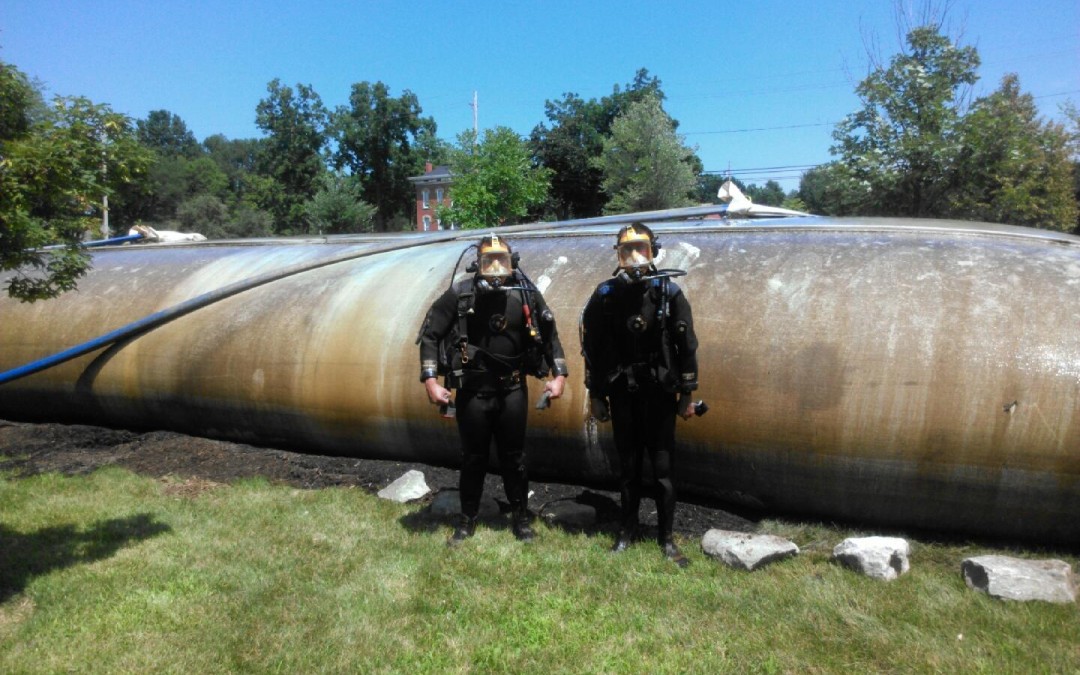
by John Monahan | Apr 1, 2015 | Geotextile Containers
Geotextile containers are what we use when vacuuming the sediment from your pond. The muck from the bottom of the pond is sucked up and discharged into them. They’re also sometimes called de-watering bags, geotextile tubes or silt containers.

Geotextile tubes filling up on a job site in Lexington, KY.
The geotextile fabric they’re made of passively filters out the water. The fabric will not allow sediment through or allow rain water to seep in.
This allows the sediment to completely dry in place. The sediment can then be used for landscaping projects to help beautify the area. It can be mixed with compost to enrich the soil. Alternately the sediment can be graded where it is and have grass seeded in it.
For this reason we recommend putting much thought into the placement of the geotextile tubes. Sediment Removal Solutions of Ohio can assist with this. We have a PDF that should help you with placement and finding the right grade in preparation of receiving the geotextile container.
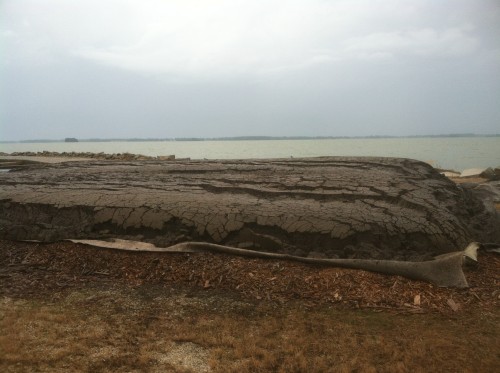
Sediment from a filled geotextile container, after it has been allowed to dry. This was at the Celina, Ohio Moose Lodge.
Without using these containers, there is a huge cost in hauling away the wet sludge. Using geotextile containers also gives you other options so that you don’t have to haul away the material. But even if you decide to haul it away, hauling costs are greatly reduced, simply by removing all the water weight.
They are extremely effective and are a huge part of our process. They will help you reduce hauling costs and/or help you to enrich the landscape surrounding your pond.
Do you have questions about the process? We’re here to help.
Call us (1-877-772-MUCK) or email us!
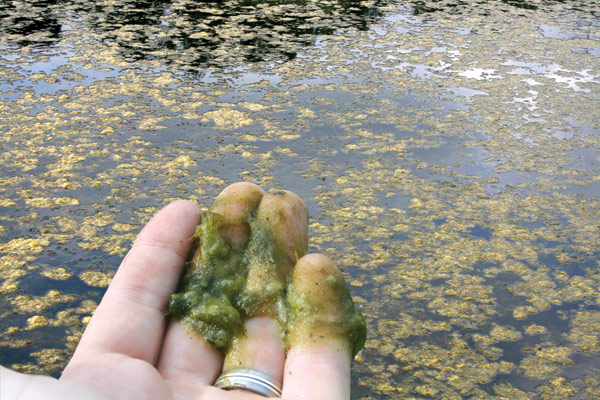
by John Monahan | Mar 5, 2015 | Farm Ponds, Pond Maintenance
Filamentous algae, commonly called “moss”, or “pond moss”, is prevalent in many organically rich pond environments.
This moss covers the surface of the water and is aesthetically displeasing. Chemicals can kill algae, but the breakdown of the dead plants just adds more nutrients for the next generation of algae.
Because farm ponds typically contain runoff water from phosphorus and other chemicals, algae can be more prevalent and problematic there. Phosphorus is commonly used as fertilizer for farming. Unfortunately the downside is that it can go into nearby water sources and help to create algae blooms.
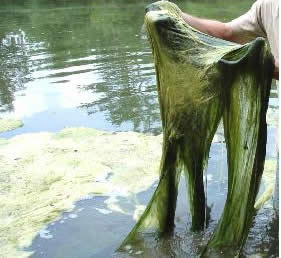
Filamentous algae pulled right out of a farm pond
Phosphorus is a weird chemical too… unlike other fertilizers such as nitrogen, phosphorus doesn’t soak into the ground as easily. Instead, phosphorus moves downhill across fields. This is why it has been such a big problem in some larger lakes, creating toxic algae blooms in areas such as Toledo, Ohio and Grand Lake St. Marys, Ohio.
The physical removal of the floating algae is very time consuming and is short lasting. The algae soon reappear in just a few short days.
To control moss you must control or manipulate its resources.
Algae need 3 resources to thrive. Take away or manipulate their nutrients (sediment removal), environment (aeration), and sunlight (pond dye) and you can control this pesky plant.
If you need some help with your pond, contact us today! We’d love to help.
Call us (1-877-772-MUCK) or email us!



